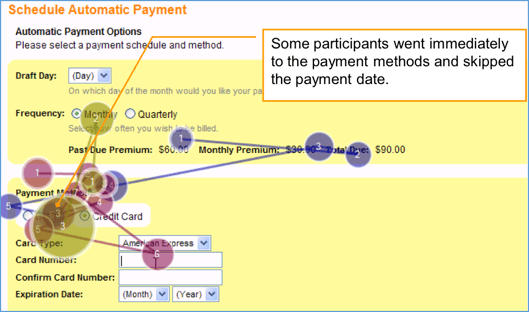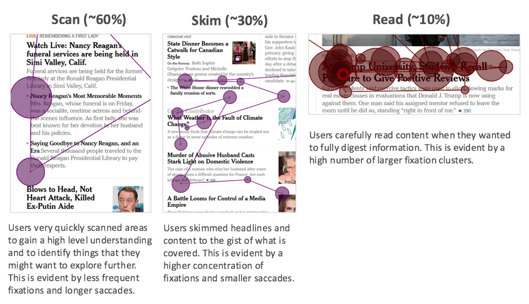
Eye tracking often receives a bad rap for being an overly expensive and time-consuming appliance that does not add any value to user experience research. These perceptions are often based in a misunderstanding of when and how eye tracking should be used to understand user behavior. Eye tracking provides the most value to researchers when:
- Attempting to understand the breakdown event during a usability test task.
- Evaluating the level of engagement users have with online content.
- Exploring how users interact with a device in a real world environment.
So what can eye tracking tell us that we didn't already know? This article provides three situations in which eye tracking provided useful insights that enabled researchers to better understand the user’s experience on mobile devices.
Understanding the breakdown event
Eye tracking is a great tool to help us understand what happens in what I call the breakdown event. The breakdown event is something that goes wrong during a usability test during task completion.
In this example, participants were asked to complete a form to sign up for a new service. During the sign up process, we noticed that several participants were skipping a critical field necessary to completing the sign up successfully.

The scan paths from the eye tracking revealed to us that many of the participants' eyes initially jumped further down on the screen, completely missing this key field!
Eye tracking helped to uncover exactly what was causing the breakdown event to occur and helped the designers to come up with a plan to fix the problem.
Eye tracking clearly revealed to us the problem that was occurring (users did not notice the payment schedule fields), however, it did not reveal WHY they weren't looking at it. Once we saw this eye gaze pattern occurring for several participants, we needed to ask them directly why they weren't looking at it.
We discovered that users were specifically looking to enter their payment information on this page and did not expect to enter in a payment schedule. The solution was to put the payment information fields above the payment scheduling (where users were looking for it) and more clearly indicate that payment scheduling was a required field.
meaSuring user engagement
In nearly all cases, the user experience of digital interfaces is driven by visual output. These days, user experience designers are creating visual content for everything from wall-mounted displays, to laptops, to mobile devices.
Our visual field is constantly being bombarded by many concurrent stimuli. We are overloaded and overwhelmed by visual information, and we constantly resort to prioritizing what we pay attention to. To measure the effectiveness of content, researchers need to determine what users are looking at and what they choose or do not choose to engage with.
It has long been known that the consumption of digital media is fundamentally different than print. Eye tracking provides insights into how users consume content on their mobile devices, and can help designers to understand when their users are scanning, skimming, or reading their content. Insights can include:
- How quickly do they notice each of the on-screen elements?
- How long do they spend looking at specific defined areas on the screen?
- How many times do they look at these defined areas during a viewing period?
- Do they read the bullets and headlines? How many do they read?

It would be nearly impossible to understand how users consume content without understanding exactly what they are looking at. This information is critical to designers as they continually tweak the layout and type of content being presented.
Seeing through the user's eyes
The mobile experience is all about context. Users consume content on their mobile phones in a variety of environments (e.g. classrooms, trains, shopping malls, etc.) and can be in situations that are continually changing. There are numerous external factors that can impact the user’s sustained attention while consuming content on their device that include distractions and disruptions.
Compared with traditional user experience research methods, such as user interviews and diary studies, eye tracking can provide deeper insights into how users consume and interact with content on their mobile device.

Mobile experiences are highly contextual and it can be difficult to recreate the mobile user’s environment within a lab setting. By using eye tracking glasses we are able to see a first person perspective on what the user is able to see and, specifically, what they are looking at in real-time. Eye tracking glasses provide us insights that include:
- What eye movement behavior patterns emerge as users interact with a mobile product.
- How much time the user focuses on certain aspects of the mobile experience.
- How environmental factors (e.g. distractions, disruptions, etc.) affect mobile content viewing behavior.
These qualitative and quantitative measurements gained from eye tracking are then combined with observational and self-reported data to paint a clear picture of how the user is experiencing a product.

[Caption: Eye tracking allows us to see through the user’s eyes and gain an understanding of their eyes field-of-view, as well as what they are focusing on at any given time. This is particularly useful when researching the dynamic uses of wearable devices.]
Where to learn more
For an overview of how eye tracking is being used by UX professionals, check out the book called Eye Tracking in User Experience Design, which provides real world examples of eye tracking in user experience research.
For the latest uses of eye tracking for mobile devices and wearables check out our past webinar Eye Tracking the Mobile User Experience and our blog article entitled, Eye Tracking Provides Insights into Wearable Device Use for insights into how to learn more about your users’ wearable behaviors.
READ MORE: User Research Methods for Automotive User Experience, Eye Tracking: Why Are We Trained to Recognize Other Human Faces?, All Eyes (Tracking) on Dallas Last Week, KLI/THQ to Present Experiences Conducting Eye Tracking for Gaming at IUE Conference










Comments
Add Comment